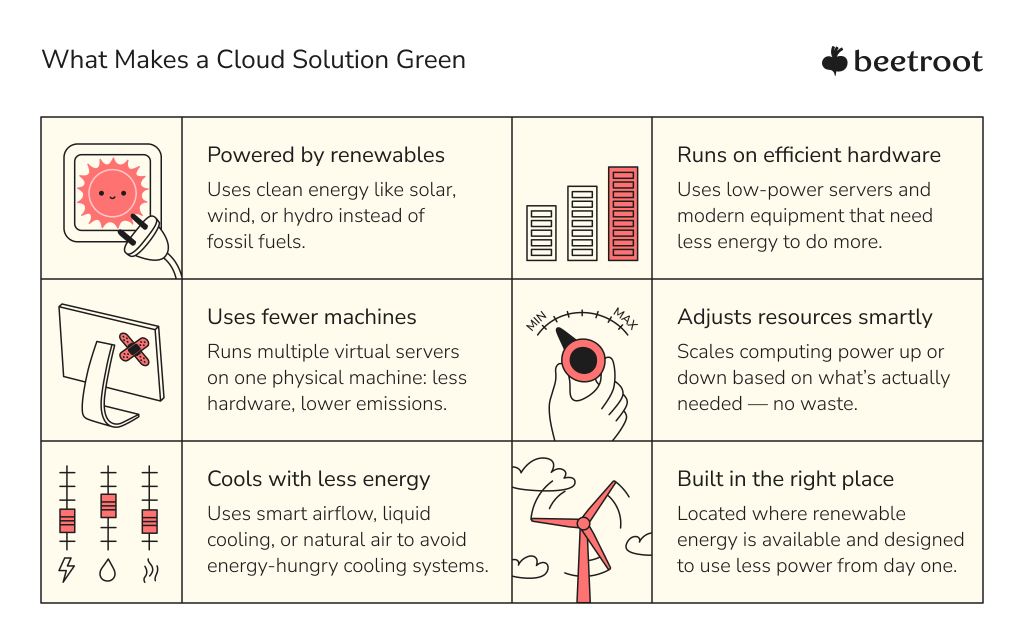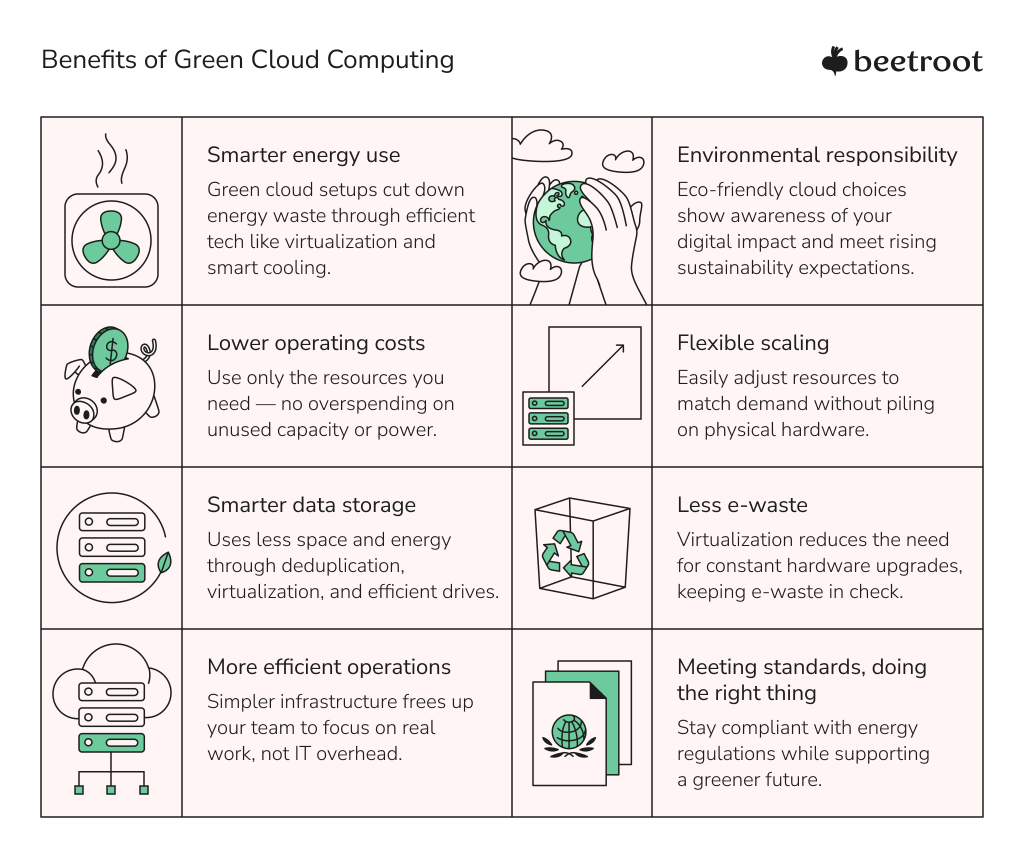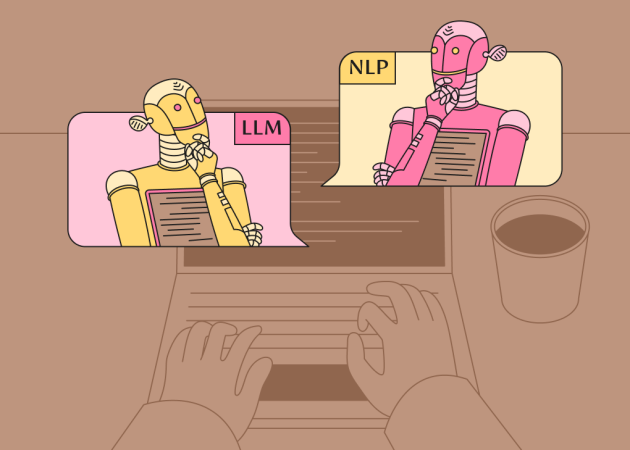
Cloud Solutions for GreenTech: Reducing Carbon Footprints Through Smarter Infrastructure
Contents
Contents
Cloud computing now powers most digital businesses, but it comes with a growing environmental cost. In 2024, the number of hyperscale data centers surpassed 1,000 globally, driven by demand for AI, big data, and always-on services. These facilities deliver computing at scale, but they also consume vast amounts of energy and water — about on par with the entire airline industry.
Other estimates suggest that the carbon trail of data centers already exceeds that of commercial aviation, accounting for 2.5–3.7% of global greenhouse gas (GHG) emissions. Without intervention, the environmental toll of cloud technology will continue to grow.
The rise of sustainable cloud computing enables digital growth while reducing environmental footprint. This article explores what a “green” cloud is, why it matters, and how your organization can transition to energy efficiency and smarter infrastructure.
What Is Green Cloud Computing?
Green cloud computing refers to eco-friendly cloud setups that prioritize sustainability in IT operations. In practice, this means designing and running cloud infrastructure that uses resources efficiently and draws power from clean sources to lower the carbon footprint of digital services.
The shift to cloud technology already improves sustainability. For instance, moving on-premises workloads to the cloud can yield some “green” benefits by consolidating servers and improving utilization. However, true green cloud computing extends to aligning cloud operations with energy-efficient infrastructure, often supported by providers that actively develop zero-carbon data centers.
This dual effort results in “green cloud” environments that benefit both the vendor’s and the client’s climate goals.

Why GreenTech Companies Should Care About Cloud Sustainability
Here’s why a more sustainable cloud setup should be on your radar, especially if your organization is building solutions for climate or environmental impact:
Regulatory Pressures and Compliance
Globally, governments are enacting stricter regulations to curb carbon emissions in the IT sector. For instance, the EU is introducing new rules requiring large data center operators to report energy usage, carbon output, water usage, and other sustainability metrics. Likewise, the U.S. SEC is moving toward climate-related disclosures.
GreenTech companies need to stay ahead of these requirements. Embracing sustainable cloud practices early helps ensure regulatory compliance and avoids future penalties or carbon taxes as laws tighten.
Credibility and Stakeholder Trust
Companies today face pressure to report and reduce their carbon footprint as part of ESG (Environmental, Social, Governance) expectations. Data centers account for a large portion of a tech company’s emissions, falling under Scope 3 reporting.
Managing your CO2 impact supports measurable progress on ESG and sustainability commitments, so reducing cloud-related footprint is key to meeting corporate sustainability targets. Investors are paying close attention to ESG performance, and consumers prefer environmentally responsible businesses.

Cost Savings and Operational Efficiency
There is a strong alignment between cost optimization and cloud sustainability, which has given rise to the concept of GreenOps — we’ll get back to it in a while. Studies indicate that a significant portion of cloud spend (an estimated 21%) is actually wasted on unused or underutilized resources.
Green cloud practices target this waste. Many measures that cut cloud costs, such as eliminating idle resources, right-sizing over-provisioned servers, and optimizing workloads, also cut energy usage and emissions, turning inefficiency into both financial savings and environmental benefits.
Early Adoption and Future-Proofing
Tech firms that build green principles into their cloud architecture now will be better positioned as sustainability becomes a standard criterion for business partnerships, procurement, and talent attraction. Early adoption allows companies to develop expertise and processes (like carbon accounting for IT) before they become mandatory.
Investing in green cloud solutions can drive innovation, for example, exploring serverless computing, AI-driven optimizations, or renewable energy integration in IT. These technologies help businesses reduce environmental impact and improve resilience and performance.
The Environmental Impact of Traditional Cloud Computing
While cloud computing is more efficient than traditional on-premise setups, large-scale data centers contribute to GHG emissions in the following key impact areas:
Energy Demand & Carbon Emissions
The electricity consumption of cloud infrastructures translates directly into CO2 output if the energy comes from fossil fuels. Older or less optimized data centers rely heavily on the conventional electric grid, which in many regions still has a high carbon intensity (coal, natural gas, etc.). Without mitigation, the aggregate carbon footprint of cloud infrastructure will keep climbing as demand grows.
Cooling & Water Usage
High energy usage in data centers also generates intense heat that must be removed to keep servers operational. Traditional cooling methods (like air conditioning and evaporative cooling) are energy- and water-intensive: cooling can account for up to 40-45% of a data center’s total energy consumption.
An average U.S. data center uses about 300,000 gallons of water each day for cooling. This strains local water resources, especially in areas prone to drought or water scarcity. In addition to the carbon footprint of the consumed electricity, traditional systems are also responsible for thermal pollution (hot water discharge).
Hardware & E-Waste
Cloud computing relies on large quantities of physical hardware like servers, networking gear, and storage devices, all having their own environmental impact in manufacturing and disposal. Frequent hardware refresh cycles in traditional IT infrastructure contribute to growing electronic waste, which poses environmental hazards, such as toxic materials in landfills, etc.
By contrast, a greener approach emphasizes extending hardware life (through higher utilization) and ensuring proper recycling, thereby cutting down on e-waste generation.
Green Cloud vs. Traditional Cloud
The table below compares these and other aspects of traditional and green cloud computing:
| Aspect | Traditional Cloud Computing | Green Cloud Computing |
| Energy Sources | Primarily relies on conventional energy sources, including fossil fuels. | Prioritizes renewable energy such as wind, solar, and hydroelectric power. Amazon met its 100% renewable energy goal in 2023, and Google intends to operate carbon-free by 2030. |
| Carbon Footprint | Higher carbon footprint due to dependence on non-renewable energy. | Strives for a reduced carbon footprint by utilizing clean energy and implementing energy-efficient practices. Microsoft Azure aims to be carbon-negative by 2030. |
| Resource Utilization | May involve underutilized servers, leading to energy inefficiencies. | Focuses on optimizing resource utilization through virtualization and efficient workload distribution to minimize energy waste. |
| Data Center Design | Standard data center designs without specific emphasis on environmental impact. | Incorporates eco-friendly designs, such as energy-efficient buildings, cooling systems, and sustainable materials. |
| Provider Initiatives | Providers may have general sustainability goals without specific commitments. | Leading providers have committed to low-carbon and net zero emissions and increased use of renewable energy. |
| Cost Implications | Initial setup may be less expensive, but energy inefficiencies can result in higher operational costs. | Green technologies require higher upfront investments, but operational costs are often lower due to energy savings and potential tax incentives. |
| Regulatory Compliance | Possible challenges in meeting stringent environmental regulations. | Proactively aligns with environmental standards and regulations, potentially avoiding fines and benefiting from incentives. |
| Public Perception | Increasing scrutiny from consumers and stakeholders regarding environmental impact. | Positively viewed by environmentally conscious consumers and organizations, enhancing brand reputation. |
GreenOps in Sustainable Cloud Practices
What is GreenOps? It’s the practice of managing cloud operations with sustainability in mind — much like FinOps focuses on financial efficiency. Simply put, GreenOps involves making operational decisions (in deployment, management, and monitoring of cloud workloads) to reduce energy consumption and emissions, just as FinOps focuses on reducing cost.
The Synergy Between GreenOps and FinOps
Both GreenOps and FinOps aim for efficient cloud utilization. Concrete tasks like instance right-sizing, scheduling virtual machines (VMs) to shut down during off hours, cleaning up unused storage, and using cheaper (often more efficient) services are classic FinOps measures that also serve GreenOps goals.
However, GreenOps may involve additional considerations, such as choosing a slightly higher-cost option if it’s about lower carbon (e.g., running jobs in regions with renewable energy even if the computing cost is a bit more). In practice, companies increasingly combine FinOps and GreenOps to achieve a more cost-effective and sustainable cloud setup.

Implementing GreenOps
GreenOps integrates sustainability into operations by introducing carbon monitoring alongside traditional performance/cost tracking, allowing teams to identify “carbon hot spots” in their architecture (specific services or regions with a high footprint) and take action.
Most GreenOps wins come from eliminating unnecessary consumption. That means shifting from overprovisioned systems to right-sized, data-driven cloud environments that scale with actual usage, often supported by DevOps practices that prioritize automation and accountability.
For example, Netflix, a heavy AWS user, implemented a predictive auto-scaling system that adjusts its cloud resources based on demand forecasts, allowing the company to save money and energy and better align with sustainability goals.
Strategies for Implementing Sustainable Cloud Solutions
Achieving a green cloud requires a layered approach. If you’re ready to build or optimize with sustainability in mind, these strategies can help you transition to sustainable cloud services:
Use low-carbon cloud regions. Renewable energy sourcing is one of the most impactful strategies to power data centers, so choosing a cloud provider with a carbon-free portfolio is a quick win. All major providers, including Amazon Web Services, Microsoft, and Google, now disclose regional carbon intensity. For instance, Google Cloud labels certain regions as “low carbon” because they have a high percentage of renewable power.
Adopt energy-efficient services. Serverless, containerized, or ARM-based compute options offer better performance per watt. Running multiple VMs or containers on a single physical server helps providers maximize utilization and reduce the total number of servers required. Higher utilization means the energy overhead (idle power) is amortized over more computing work.
Automate GreenOps. Scheduling batch jobs or intensive tasks to run at times of day when energy is cleaner or demand is lower helps reduce peak load and align with renewable availability. Use autoscaling to reduce idle load and shut down resources when they aren’t needed — for example, turn off dev/test environments when not in use (night/weekends). Optimizing storage (e.g., deleting “dark data” that’s stored but never used) can also reduce the energy and space needed for storage systems.
Optimize application design. Caching and CDNs (Content Delivery Networks) reduce redundant data transfer and computation by serving content from locations closer to the user. Efficient coding lowers CPU usage through shorter compute cycles. Multi-tenant platforms like SaaS or PaaS are often greener than running identical software on separate servers due to economies of scale.
Carbon measuring, offsetting, and beyond. Use AWS’s Carbon Footprint Tool, Google Cloud’s Carbon-Aware Compute, or Azure’s Emissions Dashboard to track impact. Many cloud providers offer carbon-neutral options by offsetting the emissions from the infrastructure (via reforestation, renewable energy certificates, etc.).
For teams investing in long-term sustainability, developing skills in areas like cloud architecture and energy-aware engineering provides the practical know-how to reduce impact at the technical level.

Key Benefits of Green Cloud Computing
The advantages of adopting green cloud computing include:
Reduced Carbon Footprint
Green cloud strategies directly lower the CO₂ output of running applications. A study by 451 Research found that migrating typical enterprise workloads to AWS resulted in an 88% reduction in carbon footprint. In short, green cloud tech enables organizations to meet sustainability targets (like carbon-neutral or net-zero goals) and contribute to global climate objectives that can be quantified in sustainability reporting.
Lower Operational Costs
Since cloud pricing is usage-based, optimizing resources also means cost efficiency. Right-sizing and auto-scaling alone can boost server utilization from 10–15% to 50–70%, meaning one server can now handle the work of 3 to 5 servers. Similarly, shutting down idle resources can save tens of thousands of dollars a year for a mid-sized workload while eliminating needless power draw.
Better Resource Management and Automation
By tracking resource utilization and eliminating waste, companies can achieve higher performance per unit of computing. Efficient cloud architectures are also easier to scale because they are not bogged down by sprawl or underutilized resources. Many green optimizations (like tuning workloads or adopting faster, more efficient software algorithms) can lead to performance gains and more reliable services.
Regulatory Readiness
Green cloud tech helps future-proof the organization against the risk of inaction on sustainability, whether it’s fines, lost business, or reputational damage. Achieving energy efficiency and low emissions in the present means future compliance requirements can be met with ease.
There’s also a supply chain angle: many large enterprises are starting to ask their suppliers (which could include smaller tech firms) for carbon data or sustainability commitments. Being able to demonstrate a green cloud approach can help maintain and win business in such an environment.
Positive Public Image and ESG Scores
Embracing green cloud technologies signals to customers and investors that a company is dedicated to its environmental responsibilities. This can differentiate a brand in the market (especially in the GreenTech sector) and attract impact-driven clients.
Furthermore, many investors use ESG criteria to evaluate companies. Showing real steps like carbon-neutral cloud operations can improve ESG ratings and open access to impact-linked financing or investment. It can also boost in-house morale: today’s tech talent, in particular, values employers who stand by their sustainability commitments.
So, a green cloud strategy has an image benefit, telling a positive story of innovation rooted in values.

Case Studies: Successful Green Cloud Implementations
Here are some real-world case studies that illustrate the practical benefits of green cloud computing for both providers and cloud users:
Amazon Web Services (AWS): Sustainable Infrastructure and Tools
AWS, the largest cloud provider, has made sustainability a core focus of its operations. A notable initiative is AWS’s pledge to reach net-zero carbon by 2040. Amazon matched 100% of consumed electricity with renewable energy sources in 2023 — seven years ahead of their original target of 2030.
AWS’s facilities are designed for high utilization and energy efficiency levels. A 451 Research study found that AWS’s infrastructure is 3.6 times more energy efficient than the average on-prem data center. Tools like the Customer Carbon Footprint Tool allow users to monitor and understand their AWS-related emissions and take action.
Case in point: Schneider Electric, a sustainability leader, used AWS to modernize its SAP platform and improve key operations, including supply chain management. By leveraging AWS tools, the company could analyze and optimize the carbon impact of its cloud architecture, aligning IT with its corporate sustainability strategy (this is documented in AWS case studies).
Overall, AWS’s journey shows how a provider can implement green cloud at scale — from running data centers on renewables to empowering customers with carbon data.

Microsoft Azure: Emissions Tracking and Carbon Negative Commitment
Microsoft, through Azure, is another leading example of green cloud implementation with a bold commitment to be carbon-negative by 2030 (removing more CO₂ than it emits) and achieve 100% renewable energy for its data centers by 2025.
Azure’s data centers have been carbon-neutral via offsetting since 2012, but Microsoft now focuses on actual reductions, including innovative projects like hydrogen fuel cell backup generators. One concrete offering from Azure is the Emissions Impact Dashboard, a tool that helps Azure customers track the emissions resulting from their cloud usage.
Case example: MSCI, a global provider of financial services and ESG analytics, migrated key applications to Azure and used Azure’s capabilities to enhance the performance and climate transparency of its cloud-based solutions. This move supported the development of products like MSCI Climate Lab and aligned with their sustainability mission (Microsoft highlighted this in a case study).
Microsoft’s own services (like Office 365, Dynamics, etc., running on Azure) achieved net-zero operations by 2022, demonstrating Azure’s ability to run large-scale workloads with zero net emissions.

Google Cloud Platform (GCP): Carbon-Intelligent Computing
Google Cloud has been carbon-neutral since 2007 and matched 100% of its energy usage with renewables since 2017. The company aims to achieve net-zero emissions across all of its operations and value chain by 2030 and run on 24/7 carbon-free energy. GCP has some of the most efficient data centers in the world.
One innovative implementation is the use of carbon-aware load shifting. GCP console provides a “lowest CO₂” recommendation for cloud resources, indicating regions and times with the lowest carbon electricity and allowing customers to choose more sustainable workload placement.
Google’s internal scheduling systems for certain batch workloads will shift computations to times/places where renewable energy is abundant (they published research on this strategy using “carbon-intelligent computing”).
Case example: Etsy, the online marketplace, migrated its infrastructure to Google Cloud to support both technical and sustainability goals. The move resulted in a 50% reduction in compute energy and a 42% drop in compute costs.
Google featured this case in a blog as an example of how cloud migration can support sustainability efforts.

Challenges and Considerations in Adopting Green Cloud Technologies
Even with strong momentum, adopting sustainable cloud computing comes with several hurdles:
Upfront investment: Transitioning to greener infrastructure can require substantial upfront costs for more efficient systems or provider migration that can deter organizations from pursuing green cloud projects. The ROI (return on investment) is realized over time through energy savings, but it requires a longer-term outlook.
Technological and skill barriers: Implementing solutions like AI-driven resource optimization, carbon-aware scheduling, or using the cloud providers’ sustainability tools requires specialized expertise. There’s also a challenge in measuring emissions, e.g., understanding full Scope 3 load, getting granular data from providers, and integrating it accurately into decision-making.
Scalability for smaller organizations: Many of the deep green innovations are driven by tech giants. Smaller organizations or startups may struggle to implement these at scale. Even when a small company wants to be sustainable, the lack of transparent carbon data or local renewable options from providers limits their choices. And if public clouds’ sustainable offerings don’t meet their specific needs, building those in-house can be too expensive.
Legacy systems and migration challenges: Many organizations still operate legacy systems in private data centers. Migrating these to a greener cloud environment can be technically challenging and fraught with concerns over data security, compliance, or downtime. Some legacy workloads might not be easily movable to the public cloud, leaving companies behind with a portion of their IT stuck in older, less efficient setups.
Lack of standardized metrics and reporting across providers and services. Companies trying to calculate their cloud carbon footprint often must rely on high-level estimations from providers. Each cloud might present carbon data differently, and it may not cover all aspects like manufacturing and network emissions, etc. Users have to navigate potential hype, greenwashing, and scrutinize the sustainability promises of vendors to ensure they’re truly adopting green technologies and not just labels.
Cultural and organizational challenges: Teams need to start caring about energy usage, not just uptime and throughput. This requires evangelism and possibly new incentives (like incorporating sustainability into KPIs). If an organization’s culture is very much to “deliver features fast,” it can be hard to introduce the extra step of thinking about environmental impact. Getting buy-in across departments (IT, finance, sustainability, operations), overcoming silos, and aligning teams on a shared mission is another hurdle to overcome.

Future Outlook for Green Cloud Technologies
The path ahead points to smarter, cleaner infrastructure driven by technological innovation, corporate and governmental climate commitments, and growing awareness. Here are some trends and expectations shaping the future outlook of green cloud computing:
Toward Zero-Carbon Data Centers
Major cloud providers have set ambitious timelines to eliminate carbon emissions from their operations. The trajectory suggests that in the next 5-10 years, cloud infrastructure will largely decouple from fossil fuel sources, either through direct green energy use or high-quality offsets/carbon removal for any residual emissions.
Advanced Cooling and Water Conservation
Next-generation cooling technologies will likely become mainstream. We’re already seeing immersive liquid cooling, cold plate cooling for CPUs/GPUs, and even experimental techniques like refrigerant-free cooling. By 2026-2030, water usage effectiveness can become a key metric alongside PUE (power usage effectiveness), with possibly more reuse of waste heat in urban heating or industrial processes.
Carbon-Aware Computing and Workload Mobility
Carbon-aware cloud computing is already on the rise and will be a major part of the future. This means cloud workloads will become smarter in scheduling and placement to take advantage of cleaner energy. Multi-cloud and edge computing might also play a role: companies could choose cloud providers or edge locations based on sustainability metrics, leading to healthier competition among providers.
Expanded Transparency and Standards
We should expect greater transparency in reporting the environmental impact of cloud services. The European Union’s initiatives (like the data center reporting and the Corporate Sustainability Reporting Directive) mean large tech companies will be disclosing energy use, efficiency, and emissions in detail. This could lead to standardized metrics, certified sustainability scores, independent cloud audits, green SLAs (service-level agreements), and more.
Innovation in Hardware and Architecture
Future servers and data center hardware will focus even more on power efficiency. Chip makers like Intel, AMD, and ARM prioritize performance-per-watt, with architectures like ARM delivering better efficiency for certain workloads. Specialized accelerators (like Google’s TPUs and AWS Inferentia) also offer faster, more energy-efficient processing for tasks like AI. Architecturally, trends like serverless, microservices, and even decentralized or quantum computing are projected to gain traction over the next decade.
Sustainable AI and Workloads
A specific area to note is the intersection of AI and sustainability. AI training can be extremely power-hungry (big models consume megawatt-hours of energy). The future likely holds improvements in how these are done — for example, scheduling AI training jobs in regions with hydro or wind surplus or developing more energy-efficient AI algorithms. Since AI development is a huge growth area for cloud usage, making AI greener is a priority.
From Potential to Action: Let’s Build Sustainable Cloud Solutions
Green cloud computing, as part of the broader sustainable development, is shifting from a niche idea to a standard in the tech industry. As this research shows, while the environmental impact of cloud services can be substantial, with the right strategies and concerted effort, it can be reduced and even reversed.
Adopting sustainable cloud practices offers a path for companies to align their digital growth with climate goals. It’s not always easy, as cost, complexity, and culture all play a role. Yet, the momentum is clearly in favor of greener approaches.
At Beetroot, we recognize the power of digital technologies, including cloud development and AI, in advancing towards the UN Sustainable Development Goals. Our approach is twofold: leveraging technology to build impact-driven software solutions and operating responsibly as a tech ecosystem. This extends to skill development and education: through our Academy, we offer expert-led targeted training to help your teams master emerging technologies and embrace greener coding practices.
If any of this speaks to your goals, feel free to reach out. We’d be glad to explore how we can support your journey.
Subscribe to blog updates
Get the best new articles in your inbox. Get the lastest content first.
Recent articles from our magazine
Contact Us
Find out how we can help extend your tech team for sustainable growth.







